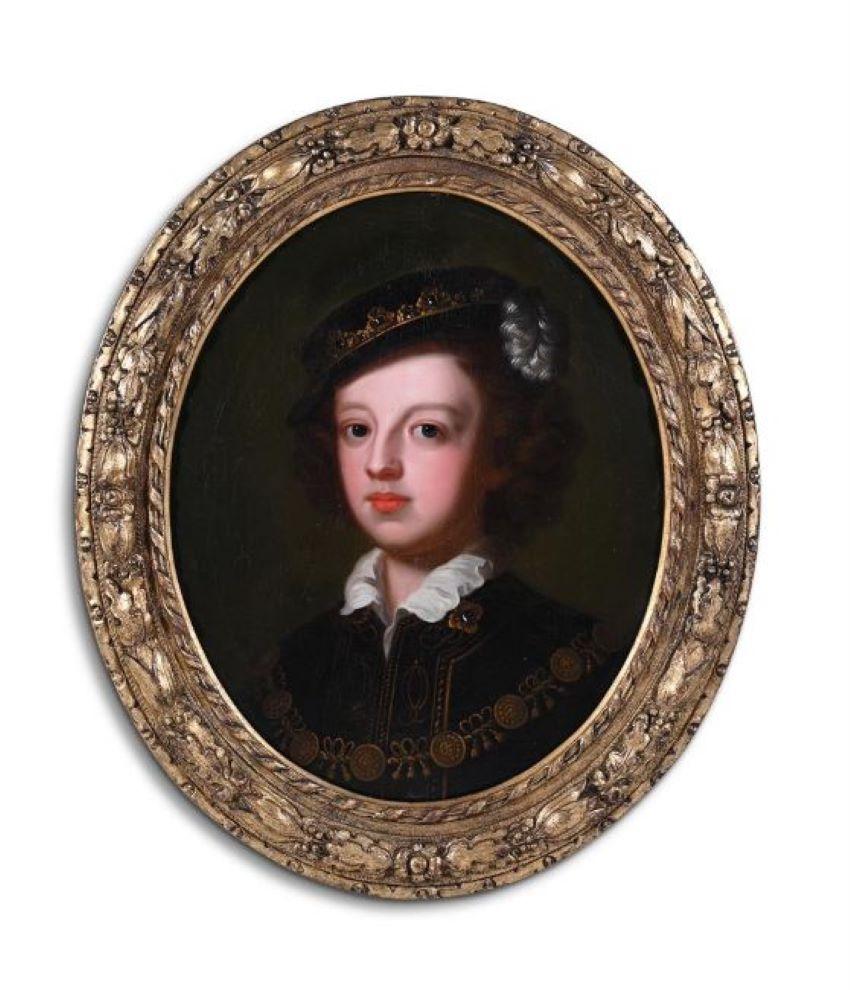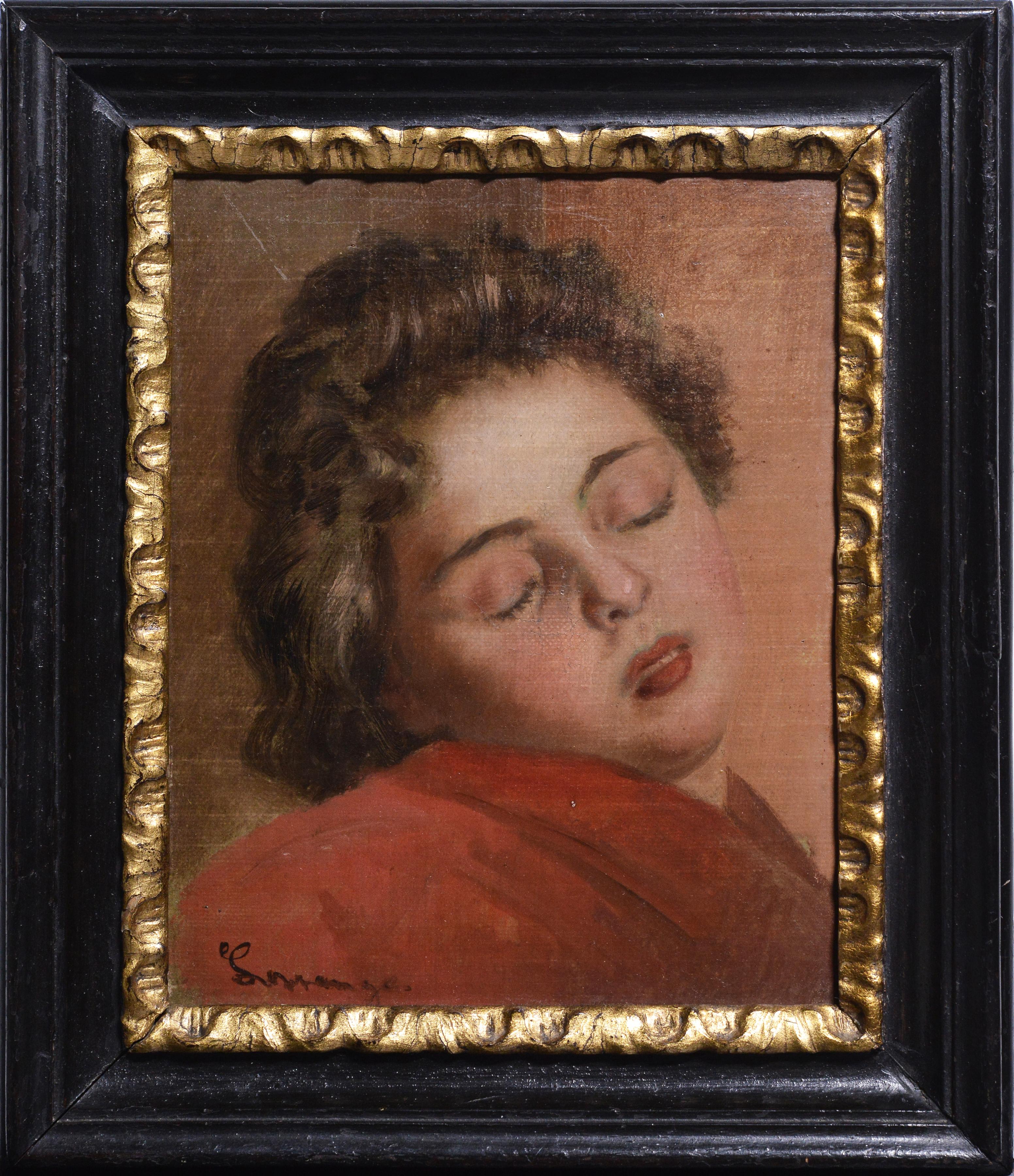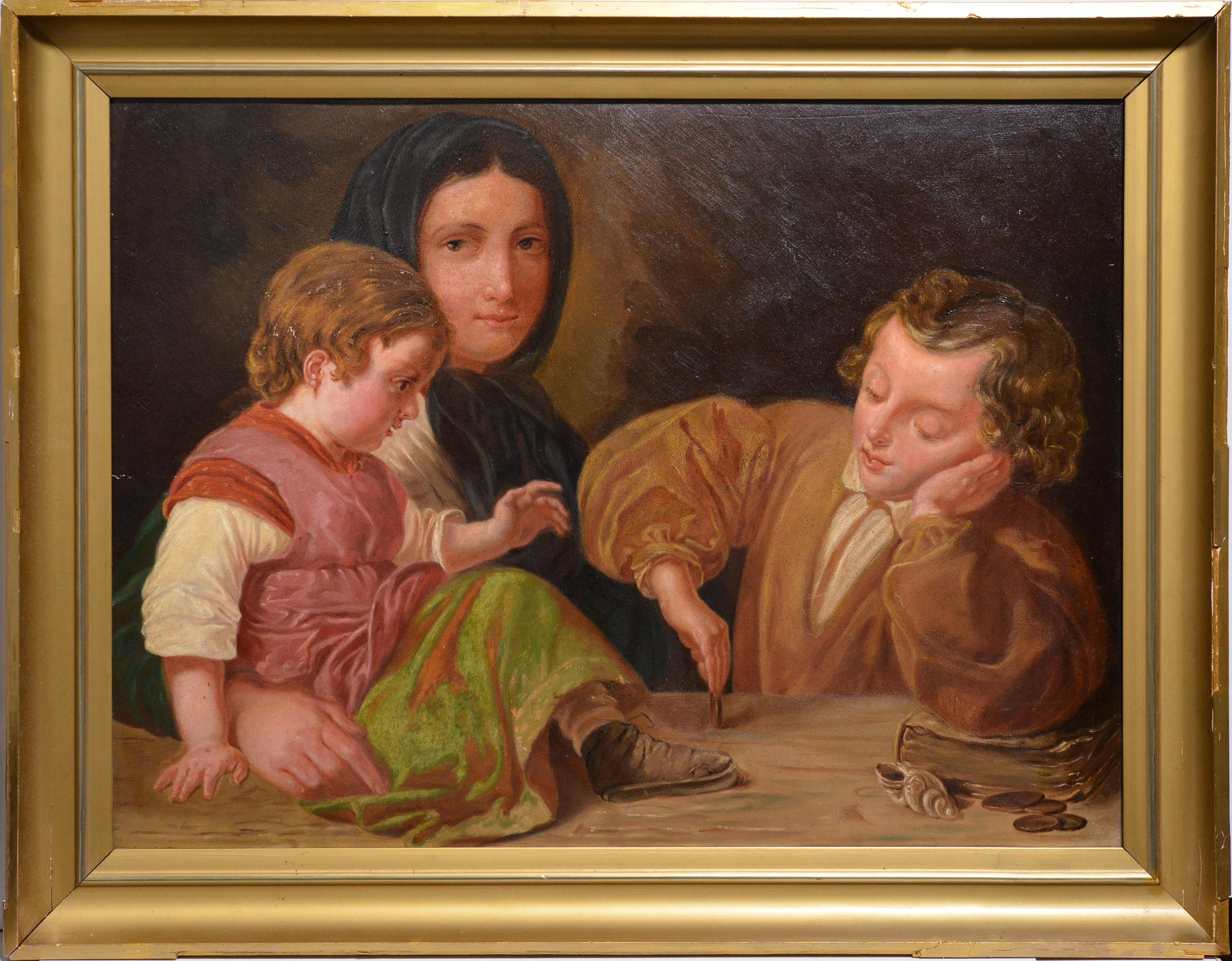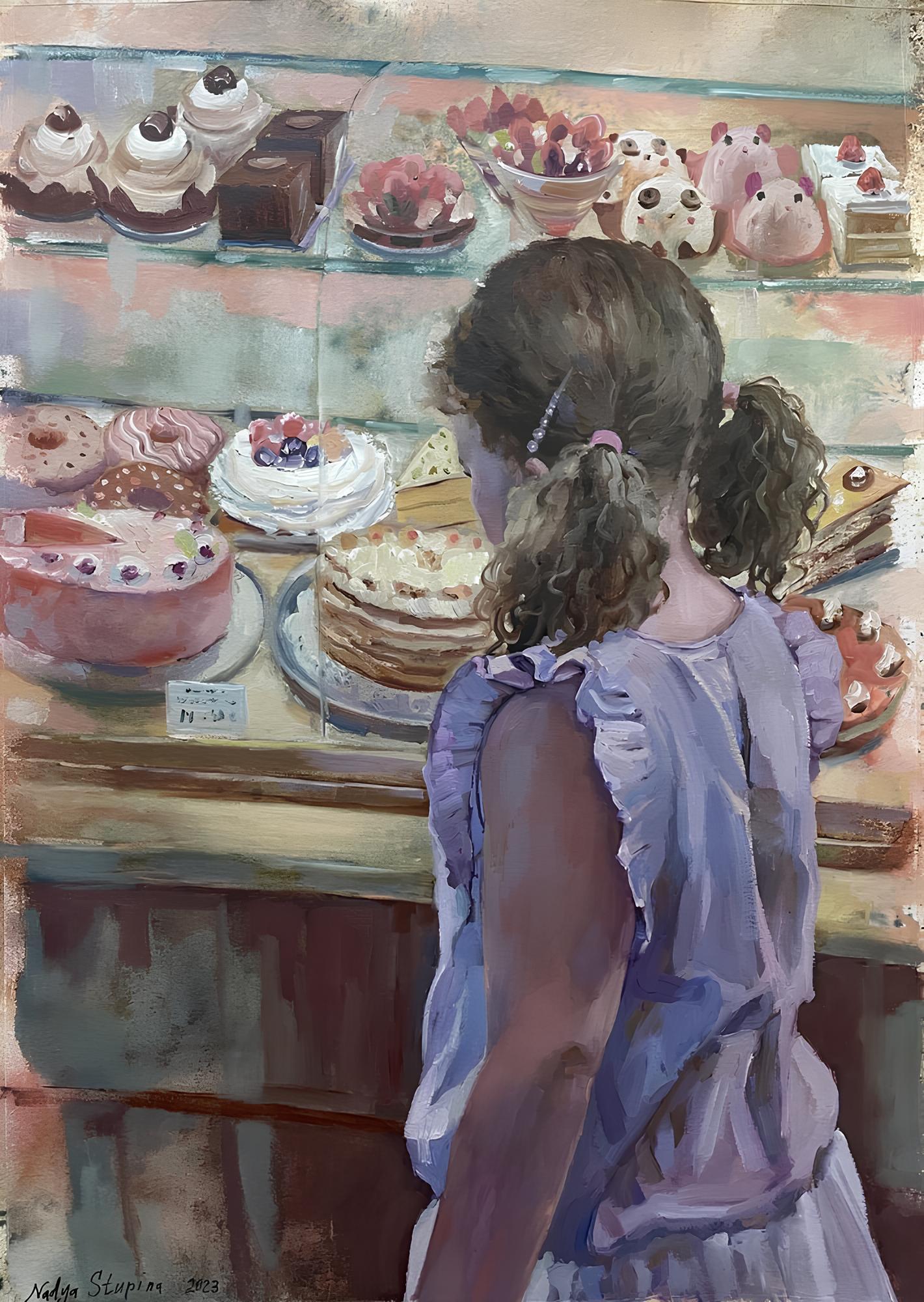Frank Owen SalisburyPortrait of a Bride - British 1934 Romantic art female portrait oil painting1934
1934
About the Item
- Creator:Frank Owen Salisbury (1874 - 1962, English)
- Creation Year:1934
- Dimensions:Height: 36 in (91.44 cm)Width: 31 in (78.74 cm)Depth: 2 in (5.08 cm)
- Medium:
- Movement & Style:
- Period:
- Condition:
- Gallery Location:London, GB
- Reference Number:1stDibs: LU853114374602
Frank Owen Salisbury
Frank Owen Salisbury was an English artist who specialized in portraits, large canvases of historical and ceremonial events, stained glass and book illustration. In his heyday, Salisbury was valued and admired on both sides of the Atlantic. In 1901, Salisbury married Alice Maude with whom he had twin daughters. His first Royal Academy exhibit was a portrait of Alice. It is for portraiture that Salisbury is best known. His speed in producing portraits stemmed from his painting his twin daughters every morning for an hour and his career began with child portraiture and his painting the Hertfordshire gentry and members of the Harpenden Methodist Church. Salisbury had a studio at his home, Sarum Chase. A providential meeting with Lord Wakefield, founder of Castrol Oils and a Methodist philanthropist, saw his introduction to society portraiture. Salisbury's being selected to paint the Boy Cornwell in the Battle of Jutland then brought him to the notice of Royalty. Lord Wakefield then arranged for him to paint President Woodrow Wilson whilst he was in London, but Wilson departed for Paris and the opportunity was lost. It was to be John W. Davis, American Ambassador to London, who encouraged Salisbury to go to the USA; Davis had met Salisbury at art receptions and had admired his child portraits. 25 members of the Royal House of Windsor sat for Salisbury and he was the first artist to paint HM Queen Elizabeth II. Salisbury painted Winston Churchill on more occasions than any other artist; the two iconic images of Churchill - The Siren Suit and Blood, Sweat and Tears are both Salisbury images. Other significant portraits include those of Richard Burton, Andrew Carnegie, Sir Alan Cobham, Sir Robert Ludwig Mond, Maria Montessori, Montgomery of Alamein, Earl Mountbatten of Burma, Benito Mussolini, John Player, Lord Rank, Jan-Christiaan Smuts and Sir Henry Wood. Salisbury was remarkably successful in the USA where he was deemed to have fulfilled the American Dream. Salisbury made 13 visits and painted six Presidents with his Franklin D. Roosevelt remaining as the official White House portrait to this day. Industrial and financial giants who sat for him included Henry Clay Folger, Elbert Henry Gary, Edward Stephen Harkness, Will Keith Kellogg, Andrew William Mellon, John Pierpont Morgan, George Mortimer Pullman, John Davison Rockefeller Jr. and Myron C. Taylor.
- ShippingRetrieving quote...Ships From: London, United Kingdom
- Return PolicyA return for this item may be initiated within 14 days of delivery.
- Portrait of Lillian Gardiner Mrs Jack Allen British Edwardian art oil paintingLocated in London, GBThis superb British portrait oil painting is by noted artist George Spencer Watson and is dateable to 1913. The sitter is Lillian Gardiner ( Mrs ...Category
1910s Realist Portrait Paintings
MaterialsOil
- Portrait of a Lady Arranging Flowers - British 1940's art oil paintingBy Sir Gerald Festus KellyLocated in London, GBThis superb British portrait oil painting is attributed to circle of Festus Kelly. Painted circa 1940 it is a half length portrait of an elegant lady in a light blue dress, pearls an...Category
1940s Realist Portrait Paintings
MaterialsOil
- The Young Art Critics - Scottish Edwardian art portrait landscape oil paintingLocated in London, GBThis lovely Edwardian exhibited portrait landscape oil painting is by noted Scottish artist James Riddel. It was exhibited at the Royal Scottish Academy in 1909 and again in Glasgow Institute in 1913, entitled The Critics. Painted circa 1909, the painting has the muted tones but varied palette of the Scottish School. The focus of the composition is a young boy and girl stood in the foreground, outdoors, examining a painting in progress on an easel. They look as if they are giving it very careful consideration. The artist's bag, brushes and tubes of paint lie on the grass beneath the easel but he is not in view. The painting is of the countryside and path leading to a collection of dwellings beyond, all bathed in sunshine. The earnestness of the young art critics can be seen in their body language and is very sweet. A really lovely exhibited Scottish Impressionist Edwardian oil painting and an excellent example of Riddel's work. Signed lower right. Provenance. Exhibited at the Royal Scottish Academy 1909 no. 294, entitled The Critics. Exhibited at the Royal Glasgow Institute of Fine Arts 1913 no. 420 entitled The Critics. Aitken Dott & Son (The Scottish Gallery), Castle Street, Edinburgh. Paisley Art...Category
Early 1900s Realist Portrait Paintings
MaterialsOil
- Philip Joubert - British art portrait oil painting senior commander 1930's WWIIBy Charles Ernest CundallLocated in London, GBPainted circa 1930 this Modern British oil portrait of Philip Joubert has superb colouring and detail. Painted by Charles Cundall RA RWS, it came from the artist’s daughter and is fr...Category
1930s Realist Portrait Paintings
MaterialsOil
- Lady in Red Portrait - British Post Impressionist 50s oil painting female artistBy Constance Anne ParkerLocated in London, GBA super circa 1955 British portrait oil painting in tones of red. A very evocative period portrait of a woman painted by British listed female artist Constance Anne Parker. A highly...Category
1950s Realist Portrait Paintings
MaterialsOil
- Young Girl - Scottish art early 20th century oil painting female portraitLocated in London, GBA fine Scottish portrait oil painting of a young girl in a red dress with pretty collar. This is a quality portrait and dates to circa 1900 and is housed in a fine Watts frame. A bea...Category
Early 20th Century Realist Portrait Paintings
MaterialsOil
- [Bruce Sargeant (1898-1938)] Five Gymnasts in TrainingBy Mark BeardLocated in New York, NYOil on canvas Signed in red, u.r. $16,000.00 + framing This artwork is offered by ClampArt, located in New York City. “Bruce Sargeant is a mythic figure in the modern art movement...Category
21st Century and Contemporary Realist Figurative Paintings
MaterialsCanvas, Oil
- ENOCH SEEMAN (circle of) PORTRAIT OF SIR FRANCIS SEYMOUR AS A BOYBy Enoch SeemanLocated in York, GBENOCH SEEMAN (circle of) PORTRAIT OF SIR FRANCIS SEYMOUR AS A BOY A very fine 18th century portrait of Sir Francis Seymour as a boy,oil on canvas housed in a gilt frame, circle of Enoch Seeman The size of the painting is 49 x 39.5cm (19¼ x 15½ in.) whilst overall the size is 65 cm x 56 cm The painting is in very good condition, the Canvas has been relined, and recently cleaned. Provenance: Anonymous sale, Christie's, 19 January 1945, lot 34 Anonymous sale, Crewkerne, Somerset, 24 April 2009, lot 1947 SIR FRANCIS SEYMOUR Francis Seymour, 1st Baron Seymour of Trowbridge (c. 1590 – 12 July 1664), of Marlborough Castle and Savernake Park in Wiltshire, was an English politician who sat in the House of Commons at various times between 1621 and 1641 when he was raised to the peerage as Baron Seymour of Trowbridge. He supported the Royalist cause during the English Civil War. In June 1611 he was accused of abetting the escape of his brother William Seymour and his wife Arabella Stuart, but protested his innocence. He was knighted by King James I at Royston on 23 October 1613. In 1612 was settled on him by his grandfather the manor of "Puriton with Downend" in Somerset, formerly one of the many possessions of his great-grandfather the 1st Duke of Somerset. In June 1642, Seymour signed the declaration that the king had no intention of war. He followed the King to York, offering to raise twenty horse in his cause, and Parliament accordingly declared him a delinquent. In autumn 1642 he went with his brother, the Marquis of Hertford, into the Westcountry to organise the royalist forces and suppress the parliamentary militia. He crossed the Bristol Channel...Category
18th Century Realist Portrait Paintings
MaterialsOil
- Portrait Sleeping Girl by Danish German Genre Painting Master 19th centuryLocated in Stockholm, SEJohann August Frederik Carl Lorange (1833 - 1875) was highly skilled Danish artist of German roots. Not much known on his biography, unfortunately, but most of his works were produc...Category
19th Century Realist Portrait Paintings
MaterialsCanvas, Wood, Oil, Wood Panel
- Family Portrait Mother with Children Playing Coins Framed Antique Oil PaintingLocated in Stockholm, SEFamily genre scene late 19th early 20th century. The boy, tired of posing for a portrait painter, decided to play by spinning a coin on the table, this game greatly impressed his you...Category
Early 20th Century Realist Figurative Paintings
MaterialsWood, Oil, Cardboard
- Rabbi in PrayerLocated in Surfside, FL20th century Judaica realist oil portrait, synagogue interior.Category
20th Century Realist Portrait Paintings
MaterialsOil, Board
- Sweet adventuresLocated in Oslo, NOIn this painting, I've poured my fascination with life's simple pleasures onto paper, capturing the innocent wonder of a child's first encounter with a world of delightful sweets. Th...Category
2010s Realist Portrait Paintings
MaterialsOil, Acrylic, Bamboo Paper
![[Bruce Sargeant (1898-1938)] Five Gymnasts in Training](https://a.1stdibscdn.com/mark-beard-paintings-bruce-sargeant-1898-1938-five-gymnasts-in-training-for-sale/a_9323/a_34005411539182323410/04_Five_Gymnasts_in_Training_980_master.jpg)





